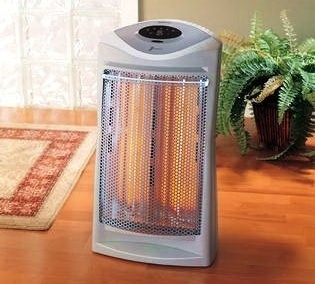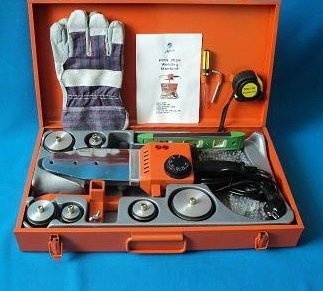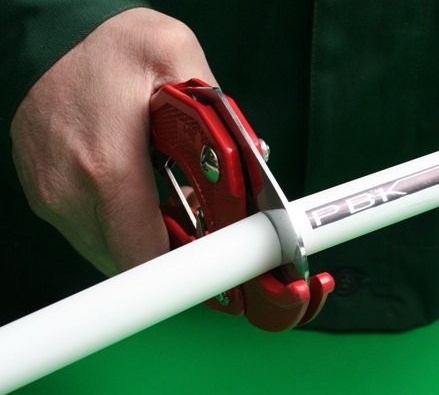How to choose a high-quality soldering iron for polypropylene pipes so as not to regret it later?
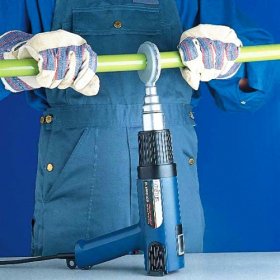
Not so long ago, exclusively metal pipes were used for apartment water supply, which were connected by welding and threaded connections. Today they are almost completely replaced by lighter and more convenient polypropylene pipes. For the installation of plastic parts, special tools, equipment are used. Of these, the most simple and affordable device for creating high-quality one-piece connections is a soldering iron for polypropylene pipes. This device is popular with masters who are independently engaged in arranging a water supply system and heating system. The market today is full of products of various manufacturers, so before you buy a soldering iron, you need to familiarize yourself with its characteristics, figure out which ones are the most important, and which ones you can pay less attention to, which manufacturers to give preference to. After reading this article, you can decide which tool is better to choose for yourself.
Content
Soldering iron device and its principle of operation
The design of various models of soldering irons is almost the same, they differ mainly in the method of attaching nozzles to a heating surface. The composition of the soldering iron includes:
- body with handle;
- welding heater in a cast metal casing;
- temperature regulator;
- special nozzles.
The soldering iron is similar in structure to a conventional iron. The difference is only in the purpose of the device and its shape. In a soldering iron, as in an iron, the main details are a powerful heating element and a temperature regulator. The heating element is built in it both in a flat case and in a round one. It is the shape of the housing that determines the variety of design of mounts for working nozzles.
The principle of operation of the soldering tool is quite simple: a heating element connected to the power grid warms up to the required temperature a stove that heats the nozzles. They then soften the polypropylene to the viscosity necessary to seal the pipes. The optimum temperature of the nozzles (approximately + 260 ° C) is supported by a temperature regulator. It controls the welding process so that the polypropylene does not melt more than necessary. Indeed, if the working nozzle is heated excessively, the joint will overheat, the polypropylene will “leak” and the diameter of the pipeline will decrease significantly or it will be damaged.
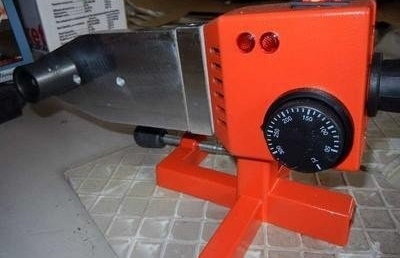
The temperature regulator is the main element of the soldering tool. It controls the heating temperature of the working nozzle, which is very important during installation
If the pipe is not heated sufficiently, this will certainly affect the tightness of the connection. In addition, the thermostat protects the heating element, preventing the metal head of the tool from melting.Inexpensive models of soldering irons are not equipped with a high-quality temperature regulator, therefore, during the soldering process, pipes can melt or get a temperature insufficient for heating. As a result, the quality of the master’s work suffers.
A separate role in the work of the soldering iron is given to nozzles. Their quality determines the reliability of the joint obtained during soldering. Nozzles are made with various coatings. When choosing a soldering iron, it is important to pay attention to the thickness of the non-stick layer. Teflon-coated nozzles, as well as metallized Teflon (even more durable version), which differ in uniform heating of the ends of polypropylene pipes, are considered durable.
Tool Selection Criteria
What are the main characteristics to look for when choosing a device? There are several of them.
Parameter # 1 - Power
This is a critical technical indicator of tool quality. It determines the maximum diameter of the connected polypropylene pipes and the heating time of the soldering iron, and, therefore, the installation speed (which is especially valuable when performing large volumes of work). But it is a mistake to assume that the best soldering iron for pipes made of polypropylene is one that has a high power consumption. Many buyers will do just that - they will buy a device with a power of 1.5-2 kilowatts, but this approach to choosing a device is wrong.

The greater the power of the soldering apparatus, the larger the diameter of the connected pipes. The tool warm-up time also depends on it, therefore, the speed of work
It is recommended that you select the power of the soldering iron according to the following rule: multiply the diameter of the connected pipes in millimeters by 10 and get the value of the minimum power of the device in watts. For example, the soldering of pipes with a diameter of 50 mm can be made by an aggregate with a capacity of at least 500 watts. For repairs in your own apartment, where pipes and fittings have a diameter of 16-63 mm, 700 watts will be sufficient. And for professional soldering of pipes with a diameter of more than 100 mm, powerful devices (1.5-2.0 kW) will be needed.
Parameter # 2 - nozzle set
The most effective is the use of a soldering iron with the simultaneous installation of several nozzles on it. They increase the functionality of the tool, expand the range of its use. Nozzles are sold for the most part complete with the device and are intended for connecting pipes of polypropylene of standard diameter. So, the 20th nozzle corresponds to a metal pipe with a diameter of 0.5 inches, the 25th and 40th nozzles correspond to a pipe with a diameter of 0.75 and 1.25 inches, respectively. If it becomes necessary to install large pipes, nozzles for the soldering iron are purchased additionally. It must be remembered, however, that using a hand-held soldering iron, only pipes made of plastic with a diameter of not more than 63 mm can be connected (corresponds to a steel pipe with a diameter of 2 inches).
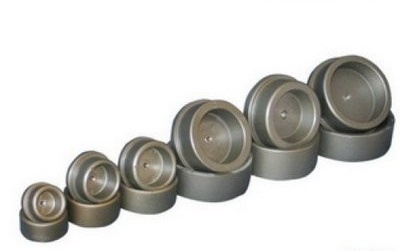
The soldering quality of polypropylene pipes largely depends on the type of coating of nozzles. The best quality indicators are demonstrated by ordinary Teflon and metallized
When choosing nozzles, it should be borne in mind that the lower the productivity of the tool, the smaller the diameter of the nozzle to be used. It is also important to keep in mind the needs of the user. Professionals have to work with 10- and 110-mm pipes. Home craftsmen work only with 3 sizes: 16 mm (0.5 inch), 24 mm (1 inch) and 32 mm (1.25 inch). It makes no sense to purchase other nozzles - this size range is sufficient for home pipelines.
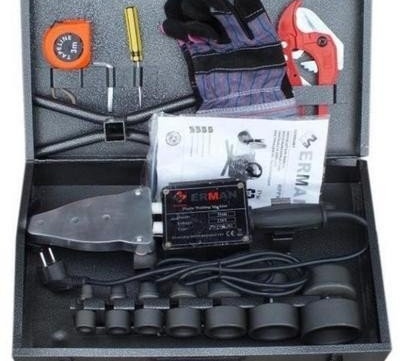
Options - a significant indicator when choosing a soldering iron. It is preferable to buy a kit in which, in addition to the soldering iron, there are nozzles of frequently used diameters, as well as the entire auxiliary tool
An important aspect is the construction material of the nozzle. The nozzles made of materials with good thermal conductivity and, as already mentioned, with a Teflon coating are considered the best.Home craftsmen need only 2-3 nozzles, so only high-quality products should be purchased.
Parameter # 3 - manufacturer and brand
When choosing a soldering iron (many call it an iron) for polypropylene pipes, you need to find out the country of manufacture of the product, because its price and quality are associated with this. Here's what an unofficial rating of a tool from different manufacturing countries looks like, compiled from customer reviews:
- Germany;
- Czech Republic;
- Turkey;
- Russia;
- China.
The most durable and durable tools are made by Germany. The German soldering iron is a perfect assistant that will last for many years. Czech devices are in high demand among professionals due to their good functionality and excellent quality. Of course, the price of European models is not affordable for everyone, but, on the other hand, with the help of a high-quality soldering iron, large volumes of work can be done.
Russian and Turkish models are slightly lower than Czech in terms of performance, but also much cheaper. For use in everyday life, they are considered a perfectly acceptable option.
The most common in our market are Chinese-made tools. They are the cheapest, but the quality is low. Although, if you observe the operating conditions, they can work out the warranty period, and sometimes longer. This option is suitable for those who use a soldering iron only 1-2 times a year.
Brief soldering technology
Soldering of pipes (pipes and fittings) made of polypropylene is carried out in the following order:
- Pipe trimming perpendicular to the central axis. Remember: with a curved end, the quality of the soldering will be no.
- Chamfering from the end of the pipe (cleaning of the cut site from chips and burrs).
- Preparing the soldering iron for work - installing nozzles on it and connecting the tool to a grounded outlet. The soldering apparatus is switched on by pressing a button on the housing. The red indicator lights up. When the red indicator turns off, this will mean that the desired heating temperature has been reached.
- Warming up the connected parts. A pipe is inserted into one side of the nozzle, a fitting into the other, and heated for 5-6 seconds. The elements of the pipeline melt, they must be quickly removed from the nozzles and connected. Polypropylene cools very quickly, after a minute the connection is ready. While the joint is cooling, it is forbidden to apply rotational movements, otherwise all the work is worthless.
Almost immediately after soldering polypropylene pipes can be used for its intended purpose. It should be noted that welding will take place more efficiently if the parts to be joined are located horizontally. In this case, the work can be done by one person. If you need to perform vertical soldering, then you need an assistant who will hold the pipe and fitting evenly.
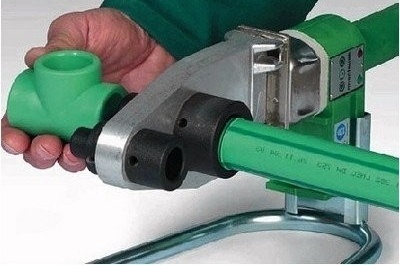
The process of soldering polypropylene pipes takes a little time - only about a minute. The main thing is to follow the rules of welding to get a high-quality tight seam
See the video technology in more detail:
When choosing a soldering tool for polypropylene pipes, every little thing must be taken into account, since the quality of the installation of the pipe often depends on them. The soldering iron should be reliable, convenient to use, have all the necessary nozzles. Remember also that the soldering must be carried out in compliance with the rules for using the device and this will help to avoid injuries and poor quality connections.
